Light sensors convert the light energy in the form of photons to electrical energy in the form of electrons. Hence, they are also called as Photo Sensors or Photo Detectors or Photo Electric Devices.
Light sensors or Photo Sensors can be classed into three types based on the physical quantity that is affected. The main classes are Photo resistors, photo voltaic and photo emitters. Photo emitters generate electricity when exposed to light. Photo resistors change their electrical properties when illuminated. Based on the above classes, the following classification of devices can be made.
Photo Emissive Cells: These types of photo devices release free electrons from light sensitive materials when strike by a photon of sufficient energy. The generally used light sensitive material is Caesium. The energy of a photon is dependent on the wavelength or frequency of the light.
The equation of energy of a photon is
E = hc / λ
Here,
h is Planck’s constant (h = 6.626 * 10-34 J s),
c is velocity of light (c = 3 * 108 m / s)
λ is wavelength of the light.
If the frequency of the light is higher, the energy of the photon is higher.Photo Conductive Cells: These types of photo devices vary their electrical property of resistance when they are subjected to light. The common type of photoconductive material is Cadmium Sulphide (CdS) which is used in Light Dependent Resistor Photocells. The photoconductivity in these cells results from light hitting a semiconductor material which controls the flow of current through it. For a given applied voltage, when the intensity of the light increases, the current also increases.
Photo Voltaic Cells: These types of photo devices generate a potential or an emf that is proportional to the energy of the radiant light. Solar Cells are a common type of photo voltaic cells and use Selenium as the photo voltaic material. They are made by sandwiching two semiconductor materials and when light energy is incident on them, a voltage of approximately 0.5 V is generated.
Photo Junction Diodes: These types of photo devices are generally semiconductor devices and use light to control the flow of electrons or holes across the junctions. Photo Diodes and Photo Transistors are the two main devices in this category. They are specifically designed for detector applications.
Light Dependent Resistor (LDR)
When subjected to light energy, a Photoconductive light sensor will change its physical property. Photo Resistor is a common type of photoconductive device. Photo resistor is a semiconductor device that uses light energy to control the flow of electrons and therefore the flow of current in them.The most common type of photoconductive cell is a Light Dependent Resistor or LDR. As the name implies, a Light Dependent Resistor is a semiconductor device that changes its electrical resistance depending on the presence of light. A Light Dependent Resistor changes its electrical resistance from a high value of several thousand Ohms in the dark to only a few hundreds of Ohms when light is incident on it by creating electron – hole pairs in the material.
The most common material used to make a Light Dependent Resistor is Cadmium Sulphide (CdS). Other materials like Lead Sulphide (PbS), Indium Antimonide (InSb) or Lead Selenide (PbSe) can also be used as the semiconductor substrate.
Cadmium Sulphide is used in Photo resistors that are sensitive to near infrared and visible light. The reason it is used is because of its close resemblance of its spectral response curve to that of the human eye. It can be controlled by a simple, light source like a flash light and the peak sensitive wavelength of Cadmium Sulphide material is about 560 nm to 600 nm in the visible spectral range.
Cadmium Sulphide is deposited as a thread pattern on an insulator in the shape of a zigzag line as shown below.
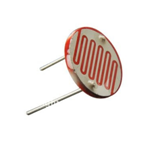
The reason for zigzag path is to increase dark resistance and therefore decrease the dark current. This cell is encapsulated in a glass to protect the substrate from contamination.
The symbol of photo resistor is shown below.
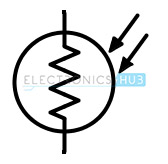
The most popular type of photoconductive cell is ORP12 Cadmium Sulphide photo conductive cell.
The characteristics of ORP12 type of photo conductor cell are as follows: the peak spectral response is 610 nm, dark resistance is 10 MΩ and resistance when illuminated is 100 Ω.
Light Dependent Resistor Voltage Divider Network
A Light Dependent Resistor is generally connected in series with a resistor with a single DC voltage supply across it. The connection is shown below.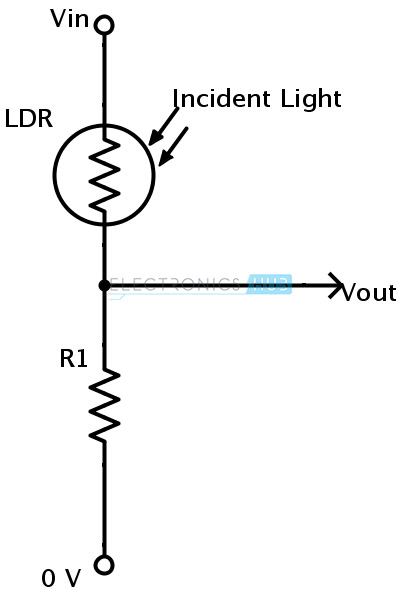
The advantage of this connection is the appearance of different voltages at their junction for different intensities of light. This connection is an example of a Voltage Divider Network or Potential Divider. The reason is because the resistive value of the light dependent resistor RLDR will determine the amount of voltage drop across the series resistor R1.
The current in a series connection is same and as the resistance of the light dependent resistor changes due to the light intensity, the output voltage will be determined by using the voltage divider formula.
The output voltage VOUT = VIN * (R1 / (RLDR + R1 )).
In the absence of light, the resistance
of a light dependent resistor is as high as 10 M Ω. In the presence of
sunlight, the resistance of a light dependent resistor will fall to 100
Ω. The variation of the resistance of a light dependent resistor over
different intensities of light is shown in the below curve.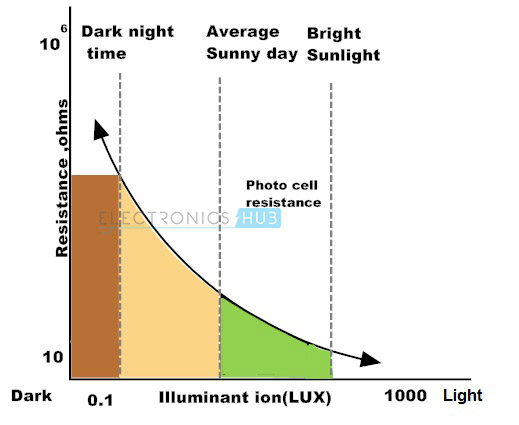
Light Sensitive Switch is a common application of Light Dependent Resistor. The circuit of a Light Dependent Resistor Switch is shown below.
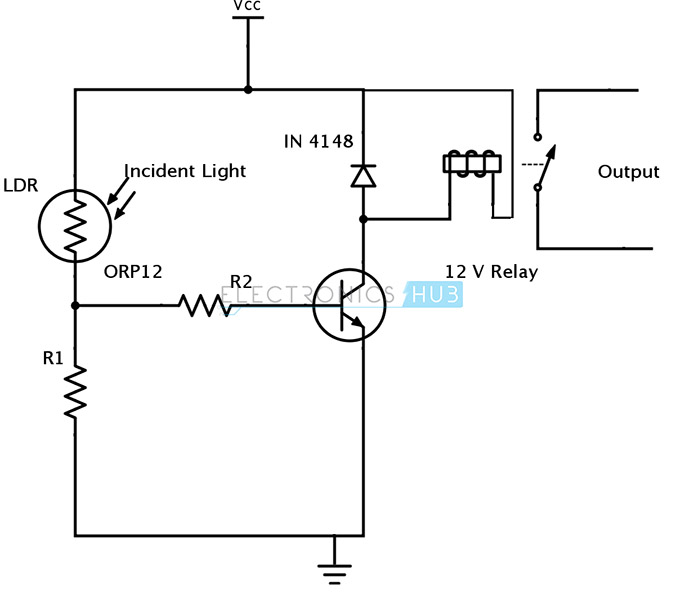
It is a light sensor circuit with relay output light activated switch. The Light Dependent Resistor RLDR and the resistor R1 form a voltage divider network. When there is no light, i.e. in darkness, the resistance of Light Dependent Resistor is in the order of mega Ohms. The base bias voltage is zero and the transistor is OFF.
As the intensity of the light increases, the resistance of the Light Dependent Resistor decreases and the bias voltage increases. At a certain point determined by the voltage divider network, the bias voltage raises enough to turn the transistor ON. This in turn activates the relay which can be used to control some other external circuit.
Light Sensing Circuit Using LDR
The sensitivity of the LDR switch is fairly low. To increase the sensitivity of light sensing, few modifications can be applied. The fixed resistor R1 is replaced with a potentiometer VR1. The transistor is replaced with an Operational Amplifier and the light dependent resistor is incorporated into a Wheatstone bridge. The new and more sensitive light sensing circuit using a light dependent resistor is shown below.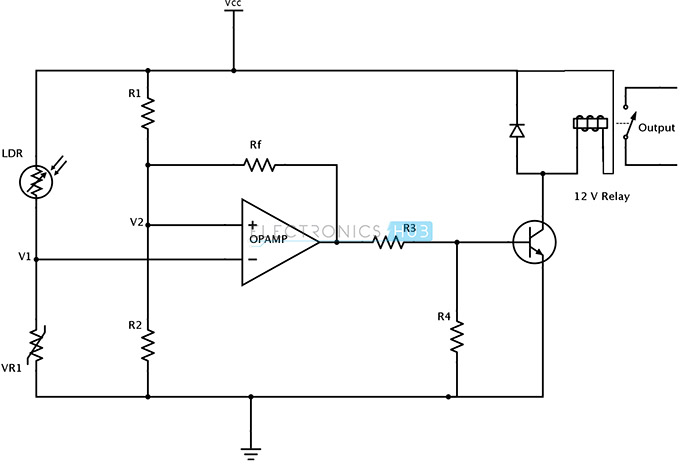
The resistors LDR, VR1, R1 and R2 will form a Wheatstone bridge. The sides of bridge LDR – VR1 and R1¬ – R2 form a potential divider with output voltages V1 and V2. These voltages are connected to non-inverting and inverting inputs of the operational amplifier respectively. The operational amplifier is operated as a differential amplifier whose output is a function of the difference between the two input voltages V1 and V2. This is also known as a voltage comparator with feedback. The feedback resistor Rf is used to provide required voltage gain.
The output of the operational amplifier is connected to a relay which can control an external circuit. When the voltage V1 due to light sensing by LDR falls below the voltage V2, which acts as a reference voltage, the output of the amplifier changes its state. This causes the relay to activate and the load is switched on.
As the intensity of the light increases, the output switches back and the relay is turned off.
Here the relay is turned on when the intensity of light is less. The operation can be reversed by reversing the positions of the light detecting resistor and potentiometer. Now the relay is turned on when the light level increases and exceeds the level set by the reference voltage.
Photodiode
Photodiode is in the class of photo junction device which is basically a PN junction light sensor. They are generally made from semiconductor PN junctions and are sensitive to visible light and infrared light. When light is incident on a Photodiode, the electrons and holes are separated and will allow the junction to conduct.Photodiodes are constructed like any other conventional junction diodes. A typical photo diode is shown below.
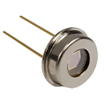
The opaque coating used in signal and rectifier diodes is absent in photo diodes. This makes the diode transparent enough to permit light and to affect the conductivity of the junction.
The symbol of a photo diode is shown below.
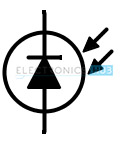





No comments:
Post a Comment